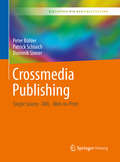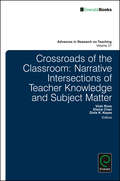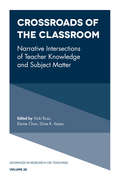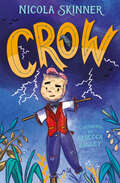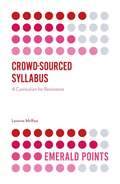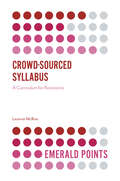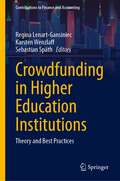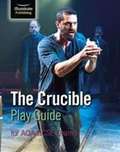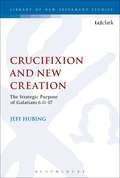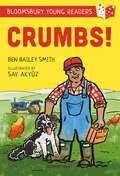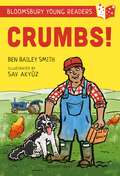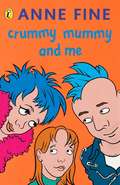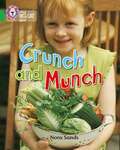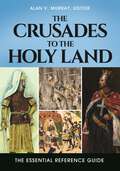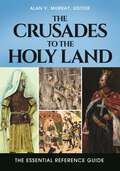- Table View
- List View
Crossmedia Publishing: Single Source – XML – Web-to-Print (Bibliothek der Mediengestaltung)
by Peter Bühler Patrick Schlaich Dominik SinnerZunächst gehen die Autoren dieses Crossmedia Publishing Buchs auf die zunehmende Bedeutung von Redaktionssystemen – speziell Content Management Systeme (kurz: CMS) – und deren Vorteile für den Publikationsprozess ein. Im weiteren Verlauf dieses Werks stehen folgende Aspekte im Fokus:XML: Grundlagen und DateibearbeitungWeb-to-Print-AnwendungenWichtige DruckdatenRich-Media-InhalteKonvertierung von PDF in HTML5So vermittelt Ihnen das Buch „Crossmedia Publishing“ nicht nur theoretische Grundlagen, sondern stellt gleichzeitig Praxisbezüge her. Verständliche Anleitungen inklusive Screenshots unterstützen Sie bei der Arbeit mit verschiedenen Tools.
Crossroads of the Classroom: Narrative Intersections of Teacher Knowledge and Subject Matter (Advances in Research on Teaching #28)
by Vicki Ross Elaine Chan Dixie K. KeyesThis book aims to explore and make visible the intersection of subject matter knowledge and teacher knowledge in the narratives of teachers. This complicated interaction between these two bodies of knowledge is often studied and little understood. This book uses narrative to examine the complexities of teaching and learning. The authors of the chapters, as well as the editors, use innovative approaches to narrative methodology for research on teaching and teacher education in areas of education critical to teachers’ lives. Particularly through this book, they continue to advance the work of researchers to display narratives of educator lives and ways of knowing while opening the space for a community of narrative scholars.
Crossroads of the Classroom: Narrative Intersections of Teacher Knowledge and Subject Matter (Advances in Research on Teaching #28)
by Vicki Ross Elaine Chan Dixie K. KeyesThis book aims to explore and make visible the intersection of subject matter knowledge and teacher knowledge in the narratives of teachers. This complicated interaction between these two bodies of knowledge is often studied and little understood. This book uses narrative to examine the complexities of teaching and learning. The authors of the chapters, as well as the editors, use innovative approaches to narrative methodology for research on teaching and teacher education in areas of education critical to teachers’ lives. Particularly through this book, they continue to advance the work of researchers to display narratives of educator lives and ways of knowing while opening the space for a community of narrative scholars.
Crow
by Nicola SkinnerNew girl Hattie hopes a scarecrow will protect her den at school, but soon Crow is taking his job far too seriously and Hattie's chances of making any friends are being ruined … A darkly comic tale from acclaimed author Nicola Skinner.
Crowd-Sourced Syllabus: A Curriculum for Resistance (Emerald Points)
by Leanne McRaeCurating the contributions of Twitter users via hashtags, crowd-sourced syllabi respond to evolving crises and critical questions in real time, resulting in living materials for educators, scholars and students. This book showcases how crowd-sourced syllabi are filling a gap in educational efficacy by providing access to forgotten, hidden, unsanctioned and unpopular resources. Recognising that educational institutions are no longer able to provide the timely and critical response to emergent situations that punctuate the everyday, Leanne McRae invites readers to re-assess the tools and frames that determine how meaning is made, and consider how by rethinking the way that syllabi are constructed, we might resist the limitations of our curriculums. By reading this book we learn how the crowd-sourced syllabus cultivates possibilities for a double refusal – the refusal to be dominated, as well as a refusal to dominate. This book is insightful reading for teachers, scholars and students who are interested in how to utilise, contribute to, and circulate the crowd-sourced syllabus in order to deepen the range, type and immediacy of resources available to us.
Crowd-Sourced Syllabus: A Curriculum for Resistance (Emerald Points)
by Leanne McRaeCurating the contributions of Twitter users via hashtags, crowd-sourced syllabi respond to evolving crises and critical questions in real time, resulting in living materials for educators, scholars and students. This book showcases how crowd-sourced syllabi are filling a gap in educational efficacy by providing access to forgotten, hidden, unsanctioned and unpopular resources. Recognising that educational institutions are no longer able to provide the timely and critical response to emergent situations that punctuate the everyday, Leanne McRae invites readers to re-assess the tools and frames that determine how meaning is made, and consider how by rethinking the way that syllabi are constructed, we might resist the limitations of our curriculums. By reading this book we learn how the crowd-sourced syllabus cultivates possibilities for a double refusal – the refusal to be dominated, as well as a refusal to dominate. This book is insightful reading for teachers, scholars and students who are interested in how to utilise, contribute to, and circulate the crowd-sourced syllabus in order to deepen the range, type and immediacy of resources available to us.
Crowdfunding in Higher Education Institutions: Theory and Best Practices (Contributions to Finance and Accounting)
by Regina Lenart-Gansiniec Karsten Wenzlaff Sebastian SpäthThis book offers a comprehensive review of crowdfunding at Higher Education Institutions, both in theory and practice. In addition, it sheds new light on the emerging concept of crowdfunding at Higher Education Institutions and presents an overview of current academic discussions and best practices regarding crowdfunding in education. Approaching crowdfunding from an integrated perspective, the book explores the relationship between crowdfunding and higher education institutions from both theoretical and practical perspectives. The theory part outlines why higher institutions should interact with crowdfunding platforms beyond the goal of simply raising funds. It continues to define science crowdfunding and education crowdfunding and provides a literature review of education crowdfunding. It follows with an outline of teaching alternative finance theory. The practice part consists of an attempt to develop a core curriculum for teaching crowdfunding, with cases stemming from university education as well as professional education. Two contributions deal with the implementation of crowdfunding platforms at universities. Furthermore, crowdfunding is then connected to non-fungible tokens used to alleviate student debt. Lastly, crowdfunding is put into the context of crowdsourcing practices. It includes contributions from international academics, scholars and professionals in the field and provides a global, multidimensional perspective on crowdfunding. Lastly, the book is unique in that it points the way forward, both for policymakers and for the research community, in terms of thinking about crowdfunding at Higher Education Institutions and the complex issues surrounding its development.
Crowdsourcing for Innovation in Higher Education (Routledge Advances in Management and Business Studies)
by Regina Lenart-Gansiniec Łukasz SułkowskiSignificant disruption to the educational sector occurred due to the COVID-19 pandemic. This shed a light on the need for new delivery methods and greater collaboration, which has become urgent and obvious as existing structures and traditional channels have struggled to cope or shut down. Higher education institutions often fail to crowdsource successfully because crowds differ in how they are organized compared to traditional sourcing. Instead of managing, higher education institutions work with external contributors who self-select into the process. Crowdsourcing has significant potential to transform the education space by enhancing existing methodologies and offering innovative possibilities to develop new pedagogical techniques. This offers benefits for practitioners, institutions, students and participants. Drawing on theory and best practice, illustrated with a wide range of the examples and cases, Crowdsourcing for Innovation in Higher Education offers invaluable guidance and will be of interest to researchers, academics, policymakers, and students in the fields of higher education, development studies, organizational studies, management science, and knowledge management.
Crowdsourcing for Innovation in Higher Education (Routledge Advances in Management and Business Studies)
by Regina Lenart-Gansiniec Łukasz SułkowskiSignificant disruption to the educational sector occurred due to the COVID-19 pandemic. This shed a light on the need for new delivery methods and greater collaboration, which has become urgent and obvious as existing structures and traditional channels have struggled to cope or shut down. Higher education institutions often fail to crowdsource successfully because crowds differ in how they are organized compared to traditional sourcing. Instead of managing, higher education institutions work with external contributors who self-select into the process. Crowdsourcing has significant potential to transform the education space by enhancing existing methodologies and offering innovative possibilities to develop new pedagogical techniques. This offers benefits for practitioners, institutions, students and participants. Drawing on theory and best practice, illustrated with a wide range of the examples and cases, Crowdsourcing for Innovation in Higher Education offers invaluable guidance and will be of interest to researchers, academics, policymakers, and students in the fields of higher education, development studies, organizational studies, management science, and knowledge management.
Crowdsourcing in Management Research: A New Tool for Scientific Inquiry (Routledge Open Business and Economics)
by Regina Lenart-GansiniecCrowdsourcing in Management Research explores the evolving landscape of academic research in the context of contemporary legal, social, cultural, and technological shifts. The book delves into the intricate processes and challenges associated with managing crowdsourcing initiatives in science. It sheds light on the essential competencies required by those initiating crowdsourcing projects, offering practical insights for effective implementation. Furthermore, the text explores the future directions of crowdsourcing in science, considering the influence of emerging technologies such as blockchain, digital storytelling, gamification, metaverse, augmented reality, and artificial intelligence. As one of the few comprehensive resources available, the book serves as a valuable guide for scholars, researchers, and graduate students interested in crowdsourcing paradigms. It emphasizes accessibility by avoiding unnecessary jargon and caters to non‑specialist readers, including booksellers and librarians. The geographical and temporal relevance of the work is underlined, providing a contemporary perspective on the subject. The inclusion of well‑known and topical case studies enhances the book’s relevance, while groundbreaking content ensures its significance in the rapidly evolving field of management research.
Crowdsourcing in Management Research: A New Tool for Scientific Inquiry (Routledge Open Business and Economics)
by Regina Lenart-GansiniecCrowdsourcing in Management Research explores the evolving landscape of academic research in the context of contemporary legal, social, cultural, and technological shifts. The book delves into the intricate processes and challenges associated with managing crowdsourcing initiatives in science. It sheds light on the essential competencies required by those initiating crowdsourcing projects, offering practical insights for effective implementation. Furthermore, the text explores the future directions of crowdsourcing in science, considering the influence of emerging technologies such as blockchain, digital storytelling, gamification, metaverse, augmented reality, and artificial intelligence. As one of the few comprehensive resources available, the book serves as a valuable guide for scholars, researchers, and graduate students interested in crowdsourcing paradigms. It emphasizes accessibility by avoiding unnecessary jargon and caters to non‑specialist readers, including booksellers and librarians. The geographical and temporal relevance of the work is underlined, providing a contemporary perspective on the subject. The inclusion of well‑known and topical case studies enhances the book’s relevance, while groundbreaking content ensures its significance in the rapidly evolving field of management research.
Crown House AQA Psychology AS level and year 1: A Level Year 1 And As
by Nigel Holt Rob Lewis Rob LewisThis new edition of the Holt and Lewis AQA Psychology textbook offers comprehensive coverage of the new AQA syllabus. Written by two experienced teachers, examiners and textbook authors, this revised edition accommodates the changes to the English AQA specification, with thorough coverage of both AS level and A level year 1. ‘Ask an examiner’ hints and tips, glossaries, web links and exam-style practice questions provide everything students need to learn and succeed. This easy-to-read, visually engaging textbook also features: evaluations of key studies, to encourage reflection and critical analysis, aid understanding and give context; detailed exploration of research methods, to help develop analytical and mathematical skills; ‘Ask an examiner’ hints and tips, practice questions and a section on exam preparation and revision, providing everything students need to prepare for their exams; lists of key terms, QR codes and web links to help explain key issues, carefully chosen images to promote debate and discussion and help ideas stick, colour-coded material for ease of use and checklists to break down everything you need to know for each topic, clearly identified A level only material, enabling it to be easily distinguished from AS material.
Crown House WJEC Psychology: AS Level
by Nicola Taylor Kirsty White Kirsty WhiteEdited by Nigel Holt and Rob Lewis, the authors of the hugely successful AS Level Psychology: The Student’s Textbook (ISBN 9781845900939) and The Study Guide (ISBN 9781845900953), Crown House WJEC Psychology: AS Level, written by Nicola Taylor and Kirsty White, rigorously examines what students need to know for the WJEC psychology AS specification. The beautifully designed, easy-to-use textbook comprehensively covers all of the course material and offers exam hints and questions to aid study. Written by experienced practicing teachers and edited by two experienced examiners, textbook authors and university lecturers, the book includes: evaluation of key studies, to encourage reflection and critical analysis, aid understanding and give context; explanations of the different psychological approaches, including positive psychology, and comparisons between them; evaluation of contemporary debates, including their economic, social and ethical implications; detailed exploration of research methods, including experimental design, research methodologies, analysing and reporting data and dealing with ethical issues; and analysis and evaluation of classic studies. Crown House WJEC Psychology: A Level will be available in 2016.
Crucial Skills: An Anger Management and Problem Solving Teaching Programme for High School Students (PDF)
by Penny Johnson Tina RaeThis programme is aimed at students (aged 11 to 16) with challenging and angry behaviours leading to disaffection and disciplinary problems. The handbook includes teacher notes, lesson plans and photocopiable resources. The 10 lessons and follow up work empower students to: " reflect on behaviour and consequences " recognise and understand feelings " develop strategies to control angry outbursts " respond to conflict without anger " resolve relationship difficulties. The programme promotes self-belief in students that they can effect change in their behaviour and achieve a positive outcome to reduce the risk of exclusion.
The Crucible of Desegregation: The Uncertain Search for Educational Equality (Chicago Series in Law and Society)
by R. Shep MelnickExamines the patchwork evolution of school desegregation policy. In 1954, the Supreme Court delivered the landmark decision of Brown v. Board of Education—establishing the right to attend a desegregated school as a national constitutional right—but the decision contained fundamental ambiguities. The Supreme Court has never offered a clear definition of what desegregation means or laid out a framework for evaluating competing interpretations. In The Crucible of Desegregation, R. Shep Melnick examines the evolution of federal school desegregation policy from 1954 through the termination of desegregation orders in the first decades of the twenty-first century, combining legal analysis with a focus on institutional relations, particularly the interactions between federal judges and administrators. Melnick argues that years of ambiguous, inconsistent, and meandering Court decisions left lower court judges adrift, forced to apply contradictory Supreme Court precedents in a wide variety of highly charged political and educational contexts. As a result, desegregation policy has been a patchwork, with lower court judges playing a crucial role and with little opportunity to analyze what worked and what didn’t. The Crucible of Desegregation reveals persistent patterns and disagreements that continue to roil education policy.
The Crucible of Desegregation: The Uncertain Search for Educational Equality (Chicago Series in Law and Society)
by R. Shep MelnickExamines the patchwork evolution of school desegregation policy. In 1954, the Supreme Court delivered the landmark decision of Brown v. Board of Education—establishing the right to attend a desegregated school as a national constitutional right—but the decision contained fundamental ambiguities. The Supreme Court has never offered a clear definition of what desegregation means or laid out a framework for evaluating competing interpretations. In The Crucible of Desegregation, R. Shep Melnick examines the evolution of federal school desegregation policy from 1954 through the termination of desegregation orders in the first decades of the twenty-first century, combining legal analysis with a focus on institutional relations, particularly the interactions between federal judges and administrators. Melnick argues that years of ambiguous, inconsistent, and meandering Court decisions left lower court judges adrift, forced to apply contradictory Supreme Court precedents in a wide variety of highly charged political and educational contexts. As a result, desegregation policy has been a patchwork, with lower court judges playing a crucial role and with little opportunity to analyze what worked and what didn’t. The Crucible of Desegregation reveals persistent patterns and disagreements that continue to roil education policy.
The Crucible Play Guide for AQA GCSE Drama (PDF)
by Annie FoxProvides structured support for the three Sections that are all part of Component 1: Understanding Drama in the specification: Section A Theatre Roles and Responsibilities. Section B Study of a Set Play Section C Understanding Drama - Live Theatre Production Fully supports the written examination and helps students develop their key knowledge and understanding of the set plays. Knowledge and understanding are developed alongside the key drama skills through a range of practical ideas and activities, tasks and exercises. Includes a dedicated section on how to improve exam and writing skills with a number of practice exam-style questions.
Crucifixion and New Creation: The Strategic Purpose of Galatians 6.11-17 (The Library of New Testament Studies #508)
by Jeff HubingThis book provides an interpretation of Galatians 6:11-17 which yields significant insights about Paul's perception of the crisis in Galatia, and the solution he presents to his readers in light of it. In the first section of the book, the epistolary form and function of Galatians 6:11-17 are analysed. Revealed as a body-closing, it works to sharpen and complete Paul's message by spelling out his motivation for writing and establishing the basis for further communication with his readers. The theme of persecution in the letter is then seen rendered both explicitly and implicitly through the examination of pertinent passages. These indicate that all parties involved share some connection to persecution. Finally, an exegetical analysis of Galatians 6:11-17 reveals Paul's claim that the agitators' primary motive is to avoid persecution 'because of the cross of Christ.' He contrasts them with himself by 'boasting' in that same cross. The net effect is that Paul draws on both the redemptive moment of Jesus' death, and the ongoing cross-shaped life he lives, to validate his apostleship.
Crumbs! A Bloomsbury Young Reader: Lime Book Band (Bloomsbury Young Readers)
by Ben Bailey SmithA fun, heartwarming animal story, ideal for children practising their reading at home or in school.Crumbs. That's all that's left in Dan's lunchbox. CRUMBS! Well who's eaten his sandwich? Could it have been Henry the horse? Bill the pig? Or even Bridget the chicken? One thing's for sure, Dan's going to find out just who ate his lovely egg mayonnaise sandwich. This fun, rhyming story from rapper, actor and comedian Ben Bailey Smith (author of the picture books Bear and Bear Moves) is perfect for children who are learning to read by themselves at Key Stage 1 (KS1). Features dynamic illustrations from Sav Akyüz and fun characters young readers will find hard to resist.Bloomsbury Young Readers are the perfect way to get children reading, with book-banded, phonically decodable stories by brilliant authors like Julia Donaldson. They are packed with gorgeous colour illustrations and include inside cover notes to help adults reading with children, as well as ideas for activities related to the stories.'Every child needs a Bloomsbury Young Reader. Fun, stretching, just the right length, full of adventurous vocabulary and punctuation.' (Julie-Ann McCulloch, Teacher)Book band: LimeIdeal for ages 6+
Crumbs! A Bloomsbury Young Reader: Lime Book Band (Bloomsbury Young Readers)
by Ben Bailey SmithA fun, heartwarming animal story, ideal for children practising their reading at home or in school, by Ben Bailey Smith, author of World Book Day book The Last Word.Crumbs. That's all that's left in Dan's lunchbox. CRUMBS! Well who's eaten his sandwich? Could it have been Henry the horse? Bill the pig? Or even Bridget the chicken? One thing's for sure, Dan's going to find out just who ate his lovely egg mayonnaise sandwich. This fun, rhyming story from rapper, actor and comedian Ben Bailey Smith (author of the picture books Bear and Bear Moves) is perfect for children who are learning to read by themselves at Key Stage 1 (KS1). Features dynamic illustrations from Sav Akyüz and fun characters young readers will find hard to resist.Bloomsbury Young Readers are the perfect way to get children reading, with book-banded, phonically decodable stories by brilliant authors like Julia Donaldson. They are packed with gorgeous colour illustrations and include inside cover notes to help adults reading with children, as well as ideas for activities related to the stories.'Every child needs a Bloomsbury Young Reader. Fun, stretching, just the right length, full of adventurous vocabulary and punctuation.' (Julie-Ann McCulloch, Teacher)Book band: LimeIdeal for ages 6+
Crummy Mummy and Me (Puffin Bks.)
by Anne Fine'I don't think my mum's fit to be a parent, really I don't.'How would you feel if your mother had royal-blue hair and wore lavender fishnet tights? But Minna's whole family (including her mum's punk boyfriend, Crusher Maggot) is a bit unusual. Being the only sensible one is not easy for Minna...
Crunch And Munch: Band 05/green (Collins Big Cat Ser.)
by Nora Sands Cliff Moon Collins Big CatFrom Jamie Oliver's favourite dinner lady, Nora Sands, this recipe book is all you need to make some great healthy meals that are fun too. Each recipe includes an ingredients list, a child-friendly method and a 'Top Tip'. There is a contents page on page 1, plus a glossary and index on pages 20 and 21. This is a Band 05/Green book in the Collins Big Cat reading programme which offers early readers patterned language and varied characters. This is an instruction text with a café menu on page 22 and opening hours on page 23 which encourage children to discuss recipes and healthy food they enjoy and would like in their own café. This story supports science learning about life processes and living things, as well as humans and other animals. It also promotes knowledge that eating the right types of food help keep humans healthy. This book has been levelled for Reading Recovery. For more guided reading books in this Collins Big Cat band, try The Magic Pen (9780007185887) written by Hiawyn Oran and illustrated by Nick Schon.
The Crusades to the Holy Land: The Essential Reference Guide
by Alan V. Murray, EditorBased on the latest scholarship by experts in the field, this work provides an accessible guide to the Crusades fought for the liberation and defense of the Holy Land—one of the most enduring and consequential conflicts of the medieval world.The Crusades to the Holy Land were one of the most important religious and social movements to emerge over the course of the Middle Ages. The warfare of the Crusades affected nearly all of Western Europe and involved members of social groups from kings and knights down to serfs and paupers. The memory of this epic long-ago conflict affects relations between the Western and Islamic worlds in the present day. The Crusades to the Holy Land: The Essential Reference Guide provides almost 90 A–Z entries that detail the history of the Crusades launched from Western Europe for the liberation or defense of the Holy Land, covering the inception of the movement by Pope Urban II in 1095 up to the early 14th century. This concise single-volume work provides accessible articles and perspective essays on the main Crusade expeditions as well as the important crusaders, countries, places, and institutions involved. Each entry is accompanied by references for further reading. Readers will follow the career of Saladin from humble beginnings to becoming ruler of Syria and Egypt and reconquering almost all of the Holy Land from its Christian rulers; learn about the main sites and characteristics of the castles that were crucial to the Christian domination of the Holy Land; and understand the key aspects of crusading, from motivation and recruitment to practicalities of finance and transport. The reference guide also includes survey articles that provide readers with an overview of the original source materials written in Latin, Arabic, Greek, Hebrew, Armenian, and Syriac.
The Crusades to the Holy Land: The Essential Reference Guide
by Alan V. MurrayBased on the latest scholarship by experts in the field, this work provides an accessible guide to the Crusades fought for the liberation and defense of the Holy Land—one of the most enduring and consequential conflicts of the medieval world.The Crusades to the Holy Land were one of the most important religious and social movements to emerge over the course of the Middle Ages. The warfare of the Crusades affected nearly all of Western Europe and involved members of social groups from kings and knights down to serfs and paupers. The memory of this epic long-ago conflict affects relations between the Western and Islamic worlds in the present day. The Crusades to the Holy Land: The Essential Reference Guide provides almost 90 A–Z entries that detail the history of the Crusades launched from Western Europe for the liberation or defense of the Holy Land, covering the inception of the movement by Pope Urban II in 1095 up to the early 14th century. This concise single-volume work provides accessible articles and perspective essays on the main Crusade expeditions as well as the important crusaders, countries, places, and institutions involved. Each entry is accompanied by references for further reading. Readers will follow the career of Saladin from humble beginnings to becoming ruler of Syria and Egypt and reconquering almost all of the Holy Land from its Christian rulers; learn about the main sites and characteristics of the castles that were crucial to the Christian domination of the Holy Land; and understand the key aspects of crusading, from motivation and recruitment to practicalities of finance and transport. The reference guide also includes survey articles that provide readers with an overview of the original source materials written in Latin, Arabic, Greek, Hebrew, Armenian, and Syriac.
Crush Step 1 E-Book: The Ultimate USMLE Step 1 Review (Crush)
by Theodore X. O'Connell Ryan Pedigo Thomas BlairWritten and reviewed by students, residents, and experts, and led by bestselling review author Dr. Ted O’Connell, Crush Step 1, 2nd Edition, is the perfect review resource you need to score high on this high-stakes exam. This comprehensive, focused resource is the most effective review tool available for truly understanding the material on which you’ll be tested. Up-to-date, easy-to-read, high-yield coverage of all the material tested on the exam. Numerous color images, helpful lists, and quick-reference tables help students retain and recall information quickly. Review questions for each chapter test student mastery of core knowledge and aid retention of high-yield facts. Test prep strategies help readers identify and understand question stems rather than memorizing buzz words. A new review board of current students and residents, as well as authors who scored within the 99th percentile on the USMLE Step 1, ensures relevance and accuracy.
